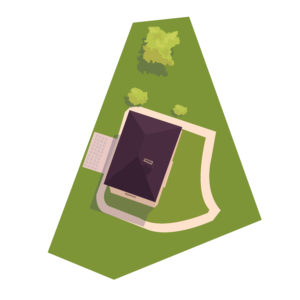Sight distance is the length of road (on both sides of a driveway entrance where it intersects a road or of a road entrance where it intersects another road) that is clear of obstructions to a driver that would be sitting at that entrance.
This distance is along a line of sight that starts a certain number of feet back from the intersecting road along the entrance and ends at the farthest point on the intersecting road (for both sides of the entrance) that a driver at the entrance would be able to see an oncoming vehicle.
Determination of Available Sight Distance
For an existing driveway or road entrance, an available sight distance is determined by measuring the required distance (depending on the reviewing agency) back from the intersecting road along the entrance, looking along the intersecting road in the direction to a point just before a driver would no longer be able to see an oncoming vehicle on the road, and then measuring the distance to that point. This process is then repeated for the other direction.
For a proposed driveway or road entrance, available sight distance is determined is the same way as above except that the sight distance would start along the proposed entrance.
Calculation of Sight Distance Required by Regulations
For a new land development project, regulations by either the local municipality or a state department of transportation (for entrances that intersect a state road) will most likely require certain minimum sight distances to be established for new driveway or road entrances.
The calculations of these new sight distances (also referred to as minimum safe stopping distances) could be based upon the posted speed limit of the intersecting road, the slope of the intersecting road, and whether the slope of the intersecting road is uphill or downhill from the entrance.
These are theoretical distances that would allow a driver at the entrance to have enough time to safely make a turn in either direction at the entrance once the driver sees that the intersecting road is clear to the farthest point along the road in the direction of oncoming traffic. In other words, an oncoming vehicle should have enough distance to stop if necessary before the entrance once the driver of that vehicle sees that someone is trying to make a turn onto the intersecting road.
How Sight Distance Is Shown on Plans
Sight distances can be shown on land development plans with dashed lines from the driveway or road entrance to the ends of the distances along the intersecting road.
They could also be represented with a label at the entrance stating the available sight distances and the required sight distances. For a proposed plan to be approved, the available sight distances would most likely have to be greater than the required sight distances.
Dealing With Insufficient Sight Distance
If there is insufficient sight distance found at an existing driveway of road entrance, a reviewing agency might require something to be done to improve the sight distance. Improvement of the sight distance could be accomplished through the grading back of some of the land at the entrance or through the removal of existing vegetation near the entrance.
If insufficient sight distances are the result of the initial layout for a new driveway or road entrance, proper sight distances might be able to be obtained also through proposed grading or vegetation removal at the entrance. If sight distances are still an issue, then the entrance might have to be relocated accordingly.
An Important Consideration for a Land Development Design
Sight distances are an important factor in the design of driveway and road entrances for safety reasons and should be considered carefully in the overall land development design process.
Related: How to Create a Land Development Design (In 12 Steps)



